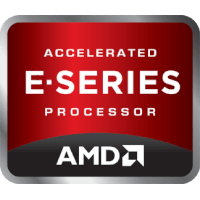AMD E1-6010
The AMD E1-6010 operates with 2 cores and 2 CPU threads. It run at -- base -- all cores while the TDP is set at 10 W.The processor is attached to the AM1 CPU socket. This version includes 1.00 MB of L3 cache on one chip, supports 1 memory channels to support DDR3L-1333 SO-DIMM RAM and features PCIe Gen lanes. Tjunction keeps below -- degrees C. In particular, Beema (Puma) Architecture is enhanced with 28 nm technology and supports AMD-V. The product was launched on Q2/2014

| Frequency | 1.35 GHz |
| CPU Cores | 2 |
| CPU Threads | 2 |
| Turbo (1 Core) | -- |
| Turbo (2 Cores): | -- |
| Hyperthreading | No |
| Overclocking | No |
| Core Architecture | normal |
Memory & PCIe
| Memory type | DDR3L-1333 SO-DIMM |
| Max memory | |
| Memory channels | 1 |
| ECC | No |
| Bandwidth | -- |
| PCIe |
Encryption
| AES-NI | Yes |
Internal Graphics
| Memory type | DDR3L-1333 SO-DIMM |
| GPU name | AMD Radeon R2 (Beema) |
| GPU frequency | 0.35 GHz |
| GPU (Turbo) | No turbo |
| Generation | 6 |
| DirectX Version | 12 |
| Execution units | 2 |
| Shader | 128 |
| Max memory | 2 GB |
| Max. displays | 2 |
| Technology | 28 nm |
| Release date | Q1/2015 |
Technical details
| Instruction set (ISA) | x86-64 (64 bit) |
| Architecture | Beema (Puma) |
| L2-Cache | -- |
| L3-Cache | 1.00 MB |
| Technology | 28 nm |
| Release date | Q2/2014 |
| Socket | AM1 |
Thermal Management
| TDP (PL1) | 10 W |
| TDP (PL2) | -- |
| TDP Up | -- |
| TDP Down | -- |
| Tjunction max | -- |
Geekbench 5, 64bit (Single-Core)
Geekbench 5 is a cross plattform benchmark that heavily uses the systems memory. A fast memory will push the result a lot. The single-core test only uses one CPU core, the amount of cores or hyperthreading ability doesn't count.
Geekbench 5, 64bit (Multi-Core)
Geekbench 5 is a cross plattform benchmark that heavily uses the systems memory. A fast memory will push the result a lot. The multi-core test involves all CPU cores and taks a big advantage of hyperthreading.
iGPU - FP32 Performance (Single-precision GFLOPS)
The theoretical computing performance of the internal graphics unit of the processor with simple accuracy (32 bit) in GFLOPS. GFLOPS indicates how many billion floating point operations the iGPU can perform per second.
Estimated results for PassMark CPU Mark
Some of the CPUs listed below have been benchmarked by CPU-Comparison. However the majority of CPUs have not been tested and the results have been estimated by a CPU-Comparison’s secret proprietary formula. As such they do not accurately reflect the actual Passmark CPU mark values and are not endorsed by PassMark Software Pty Ltd.
Cinebench R15 (Single-Core)
Cinebench R15 is the successor of Cinebench 11.5 and is also based on the Cinema 4 Suite. Cinema 4 is a worldwide used software to create 3D forms. The single-core test only uses one CPU core, the amount of cores or hyperthreading ability doesn't count.
Cinebench R15 (Multi-Core)
Cinebench R15 is the successor of Cinebench 11.5 and is also based on the Cinema 4 Suite. Cinema 4 is a worldwide used software to create 3D forms. The multi-core test involves all CPU cores and taks a big advantage of hyperthreading.
Geekbench 3, 64bit (Single-Core)
Geekbench 3 is a cross plattform benchmark that heavily uses the systems memory. A fast memory will push the result a lot. The single-core test only uses one CPU core, the amount of cores or hyperthreading ability doesn't count.
Geekbench 3, 64bit (Multi-Core)
Geekbench 3 is a cross plattform benchmark that heavily uses the systems memory. A fast memory will push the result a lot. The multi-core test involves all CPU cores and taks a big advantage of hyperthreading.
Cinebench R11.5, 64bit (Single-Core)
Cinebench 11.5 is based on the Cinema 4D Suite, a software that is popular to generate forms and other stuff in 3D. The single-core test only uses one CPU core, the amount of cores or hyperthreading ability doesn't count.
Cinebench R11.5, 64bit (Multi-Core)
Cinebench 11.5 is based on the Cinema 4D Suite, a software that is popular to generate forms and other stuff in 3D. The multi-core test involves all CPU cores and taks a big advantage of hyperthreading.


